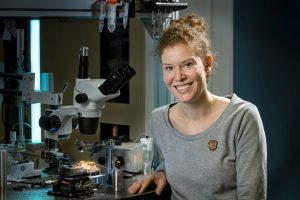Nanoparticles are omnipresent in our environment: Viruses in ambient air, proteins in the body, as building blocks of new materials for electronics, or in surface coatings. Visualizing these smallest particles is a problem: They are so small that they can hardly be seen under an optical microscope. Researchers of Karlsruhe Institute of Technology (KIT) have now developed a sensor that not only detects nanoparticles, but also determines their condition and tracks their movements in space. The highly sensitive and compact detector, a novel type of Fabry-Pérot resonator, is presented in Nature Communications (DOI: 10.1038/s41467-021-26719-5).
Conventional microscopes produce enlarged images of small structures or objects with the help of light. Nanoparticles, however, are so small that they hardly absorb or scatter light and, hence, remain invisible. Optical resonators increase the interaction between light and nanoparticles: They capture light in smallest space by reflecting it thousands of times between two mirrors. In case a nanoparticle is located in the captured light field, it interacts thousands of times with the light such that the change in light intensity can be measured. “The light field has various intensities at different points in space. This allows conclusions to be drawn with respect to the position of the nanoparticle in the three-dimensional space,” says Dr. Larissa Kohler from KIT’s Physikalisches Institut.

Physicist Larissa Kohler has developed the new optical
resonator at KIT. (Photo: Markus Breig, KIT)
Resonator Makes Movements of Nanoparticles Visible
And not only that: “If a nanoparticle is located in water, it collides with water molecules that move in arbitrary directions due to thermal energy. These collisions cause the nanoparticle to move randomly. This Brownian motion can now also be detected,” the experts adds. “So far, it has been impossible for an optical resonator to trackthe motion of a nanoparticle in space. It was only possible to state whether or not the particle is located in the light field,” Kohler explains. In the novel fiber-based Fabry-Pérot resonator, highly reflecting mirrors are located on the ends of glass fibers. It allows us to derive the hydrodynamic radius of the particle, that is the thickness of the water surrounding the particle, from its three-dimensional movement. This is important, because this thickness changes the properties of the nanoparticle. “As a result of the hydrate shell, it is possible to detect nanoparticles that would have been too small without it,” Kohler says. Moreover, the hydrate shell around proteins or other biological nanoparticles might have an impact on biological processes.
Sensor Provides Insight into Biological Processes
A potential application of the resonator may be the detection of three-dimensional motion with high temporal resolution and characterization of optical properties of biological nanoparticles, such as proteins, DNA origami, or viruses. In this way, the sensor might provide insights into not yet understood biological processes.
Original Publication
Larissa Kohler, Matthias Mader, Christian Kern, Martin Wegener, David Hunger: Tracking Brownian motion in three dimensions and characterization of individual nanoparticles using a fiber-based high-finesse microcavity. Nature Communications, 2021. DOI: 10.1038/s41467-021-26719-5
https://www.nature.com/articles/s41467-021-26719-5
In close partnership with society, KIT develops solutions for urgent challenges – from climate change, energy transition and sustainable use of natural resources to artificial intelligence, sovereignty and an aging population. As The University in the Helmholtz Association, KIT unites scientific excellence from insight to application-driven research under one roof – and is thus in a unique position to drive this transformation. As a University of Excellence, KIT offers its more than 10,000 employees and 22,800 students outstanding opportunities to shape a sustainable and resilient future. KIT – Science for Impact.

